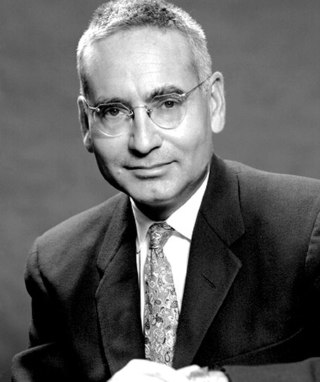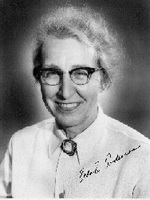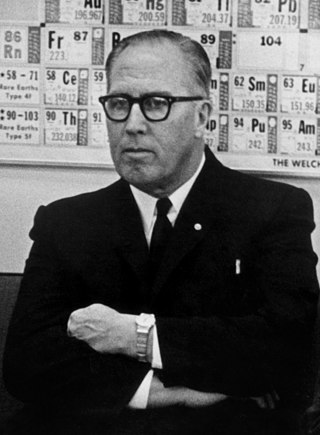Related Research Articles

Oak Ridge National Laboratory (ORNL) is a federally funded research and development center in Oak Ridge, Tennessee, United States. Founded in 1943, the laboratory is now sponsored by the United States Department of Energy and administered by UT–Battelle, LLC.

Hyman G. Rickover was an admiral in the United States Navy. He directed the original development of naval nuclear propulsion and controlled its operations for three decades as director of the U.S. Naval Reactors office. In addition, he oversaw the development of the Shippingport Atomic Power Station, the world's first commercial pressurized water reactor used for generating electricity. Rickover is also one of four people who have been awarded two Congressional Gold Medals.

Oak Ridge is a city in Anderson and Roane counties in the eastern part of the U.S. state of Tennessee, about 25 miles (40 km) west of downtown Knoxville. Oak Ridge's population was 31,402 at the 2020 census. It is part of the Knoxville Metropolitan Area. Oak Ridge's nicknames include the Atomic City, the Secret City, and the City Behind the Fence.
Bettis Atomic Power Laboratory is a U.S. Government-owned research and development facility in the Pittsburgh suburb of West Mifflin, Pennsylvania, that works exclusively on the design and development of nuclear power for the U.S. Navy. It was one of the leaders in creating the nuclear navy.
A nuclear navy, or nuclear-powered navy, refers to the portion of a navy consisting of naval ships powered by nuclear marine propulsion. The concept was revolutionary for naval warfare when first proposed. Prior to nuclear power, submarines were powered by diesel engines and could only submerge through the use of batteries. In order for these submarines to run their diesel engines and charge their batteries they would have to surface or snorkel. The use of nuclear power allowed these submarines to become true submersibles and unlike their conventional counterparts, they became limited only by crew endurance and supplies.

The United States Department of Energy National Laboratories and Technology Centers is a system of laboratories overseen by the United States Department of Energy (DOE) for scientific and technological research. The primary mission of the DOE national laboratories is to conduct research and development (R&D) addressing national priorities: energy and climate, the environment, national security, and health. Sixteen of the seventeen DOE national laboratories are federally funded research and development centers administered, managed, operated and staffed by private-sector organizations under management and operating (M&O) contracts with the DOE. The National Laboratory system was established in the wake of World War II, during which the United States had quickly set-up and pursued advanced scientific research in the sprawling Manhattan Project.

Naval Reactors (NR), which administers the Naval Nuclear Propulsion Program, is an umbrella term for the U.S. government office that has comprehensive responsibility for the safe and reliable operation of the United States Navy's nuclear reactors "from womb to tomb." A single entity, it has authority and reporting responsibilities within both the Naval Sea Systems Command and the National Nuclear Security Administration (NA-30). Moreover, the Director of Naval Reactors also serves as a special assistant to the Chief of Naval Operations for Naval Nuclear Propulsion.
Balseiro Institute is an Argentine academic institution that belongs partially to the National University of Cuyo and partially to the National Atomic Energy Commission. It is located in Bariloche, Río Negro province, Argentina. Notable alumni of this institute include Marcela Carena, Juan Maldacena, Juan Ignacio Galvan and Jorge Pullin.

North Carolina State University in 1950 founded the first university-based reactor program and Nuclear Engineering curriculum in the United States. The program continues in the early 21st century. That year, NC State College administrators approved construction of a reactor and the establishment of a collegiate nuclear engineering program. The first research reactor was completed in 1953; it was scaled up in 1957 and 1960. It was deactivated in 1973 to make way for the PULSTAR reactor. The old reactor has been decommissioned.

The Pakistan Institute of Nuclear Science & Technology (PINSTECH) is a federally funded research and development laboratory in Nilore, Islamabad, Pakistan.

Alvin Martin Weinberg was an American nuclear physicist who was the administrator of Oak Ridge National Laboratory (ORNL) during and after the Manhattan Project. He came to Oak Ridge, Tennessee, in 1945 and remained there until his death in 2006. He was the first to use the term "Faustian bargain" to describe nuclear energy.

A neutron research facility is most commonly a big laboratory operating a large-scale neutron source that provides thermal neutrons to a suite of research instruments. The neutron source usually is a research reactor or a spallation source. In some cases, a smaller facility will provide high energy neutrons using existing neutron generator technologies.

Nuclear Power School (NPS) is a technical school operated by the U.S. Navy in Goose Creek, South Carolina as a central part of a program that trains enlisted sailors, officers, KAPL civilians and Bettis civilians for shipboard nuclear power plant operation and maintenance of surface ships and submarines in the U.S. nuclear navy. As of 2020 the United States Navy operates 98 nuclear power plants, including 71 submarines, 11 aircraft carriers, two Moored Training Ships (MTS) and two land-based training plants. NPS is the centerpiece of the training pipeline for U.S. Navy nuclear operators. It follows initial training at Nuclear Field "A" School or a college degree, and culminates with certification as a nuclear operator at one of the Navy's two Nuclear Power Training Units (NPTU).

Alvin Cushman Graves was an American nuclear physicist who served at the Manhattan Project's Metallurgical Laboratory and the Los Alamos Laboratory during World War II. After the war, he became the head of the J (Test) Division at Los Alamos and was director or assistant director of numerous nuclear weapons tests during the 1940s and 1950s. Graves was severely injured in the 1946 laboratory criticality accident in Los Alamos that killed Louis Slotin, but recovered.
Alvin William Trivelpiece was an American physicist whose varied career included positions as director of the Office of Energy Research of the U.S. Department of Energy (DOE), executive officer of the American Association for the Advancement of Science (AAAS), and director of Oak Ridge National Laboratory (ORNL). He was also a professor of physics and a corporate executive. Trivelpiece's research focused on plasma physics, controlled thermonuclear research, and particle accelerators. He received several patents for accelerators and microwave devices. He died in Rancho Santa Margarita, California in August 2022 at the age of 91.

Elda Emma Anderson was an American physicist and health researcher. During World War II, she worked on the Manhattan Project at Princeton University and the Los Alamos National Laboratory, where she prepared the first sample of pure uranium-235 at the laboratory. A graduate of the University of Wisconsin, she became professor of physics at Milwaukee-Downer College in 1929. After the war, she became interested in health physics. She worked in the Health Physics Division of the Oak Ridge National Laboratory, and established the professional certification agency known as the American Board of Health Physics.

Clarence Edward Larson was an American chemist, nuclear physicist and industrial leader. He was involved in the Manhattan Project, and was later director of Oak Ridge National Laboratory and commissioner of the U.S. Atomic Energy Commission.
Everitt Pinnell Blizard was a Canadian-born American nuclear physicist and nuclear engineer, known for his work on nuclear reactor physics and shielding.
Herbert G. MacPherson was an American nuclear engineer and deputy director of Oak Ridge National Laboratory (ORNL). He contributed to the design and development of nuclear reactors and in the opinion of Alvin Weinberg he was "the country's foremost expert on graphite"...
The Fusion Pilot Plant is a program initiated in 2021 by the United States Department of Energy to construct a pilot plant capable of producing net electrical fusion power by the 2030s. In September 2022, $50 million was earmarked by the Department of Energy for development of a pilot fusion power plant. The National Academies of Sciences, Engineering and Medicine was involved in kicking off the program and advised it become a United States public-private partnership.
References
- Sources:
- "Chapter 3: Accelerating Projects". Oak Ridge National Laboratory: The First Fifty Years. Vol. 25. Oak Ridge National Laboratory. "Rickover: Setting the Nuclear Navy's Course".
{{cite book}}:|website=ignored (help) - A. W. Trivelpiece, Oak Ridge National Laboratory (1990), International Aspects of Oak Ridge National Laboratory (PDF), DOE Office of Scientific and Technical Information